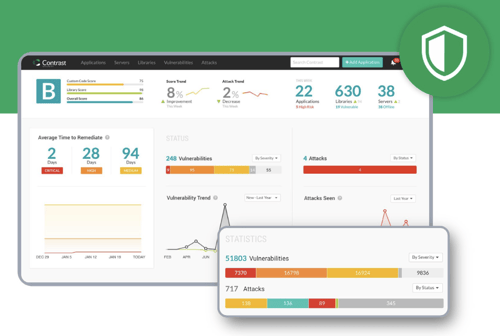
lost revenue, reputation, potential legal liability
Too much trust in...
PEOPLE
You trust your people... but they can’t afford the time to conduct exhaustive security testing and remediate all the problems
PERIMETERS
Web Application Firewalls (WAFs) and API Gateways don’t have enough context to accurately defend 100% of attacks and prevent exploitation
What would ideal defenses look like?
Very fast
Simple and verifiable
Highly accurate
Automatic without tailoring or tuning
Safe to use
Not intrusive to your teams
What should defenses do?
Prevent exploits
Detect attacks and snapshot context
Enable incident response
For production applications:
Integrates with your SIEM and SOC
Mitigates top vulnerability classes & zero-days
Supports attestation reporting & compliance
Not fixing your code, fixing security at the underlying language environment

Uses instrumentation to inject automated trust boundaries into software as it loads
Eliminate time-consuming and ineffective manual effort
Eliminate impact on developers
No code changes
No configuration needed
Fixing security at the root
Your App/API Stack

Deserialization attacks exploit a fundamental process within many applications. Applications often serialize data – converting objects into a format suitable for storage or transmission. Later, this data is deserialized back into objects for use by the application. Attackers can craft malicious payloads that, when deserialized, trigger unexpected or harmful actions within the application.
Simply prevents untrusted data from reaching a potentially dangerous module
Completely prevented Log4Shell attacks
Impossible to do accurately at the perimeter



Zero Trust for the application layer
Extremely high performance, no bottlenecks
Broad vulnerability remediation for libraries AND custom code
One time install. No change to how you build, test, deploy apps
You’ll never know it’s there unless you’re an attacker
Contrast Protect helps organizations comply with mainstream industry standards such as the National Institute of Standards and Technology (NIST) and the Payment Card Industry Software Security Standard (PCI-SSS). NIST standards are used for things such as measuring equipment and procedures and quality control. PCI-SSS are new requirements for the secure design and development of modern payment software.
RASP technology is already a requirement in NIST 800-53—which covers recommended security-control selection—and already a requirement in PCI-SSS 9.1, 10.2a, and 10.2b which defines security requirements to ensure payment software protection.
Deploy automatically via:

Reduce App/ API risk |
|
Unlock Dev productivity |
|
Strengthen the SOC |
|
Contrast detects & prevents exploitation against entire classes of vulnerabilities via embedded detection rules
Examples of zero days that Contrast mitigated before they were discovered (before CVEs were issued):
Spring/Kafka — Deserialization opens risk to Remote Code Execution - CVE-2023-34040
Spring4Shell — Command Injection/ClassLoader manipulation - CVE-2023-22965
Log4Shell — Expression Language Injection - CVE-2021-44228
Confluence OGNL Injection — CVE-2021-26084
Apache Struts2 — CVE-2020-17530
Python Salt CVEs — CVE-2020-11651 & CVE-2020-11651
Tomcat Server — CVE-2020-9484
WebLogic Remote Code Execution (RCE) — CVE-2019-2725
ApacheStruts2 — CVE-2019-0230
ApacheStruts2 — CVE-2018-11776
Jenkins XStream — CVE-2016-0792
Contrast studies new exploits and CVEs to enhance/harden the Protect rules for real-time protection (e.g., improved JDNI rules and added ClassLoader Manipulation detection).
Large insurance company |
|
Affinity membership group |
|
$120B global medical devise company |
|
Schedule a demo and see how to eliminate your application-layer blind spots.
Book a demo
